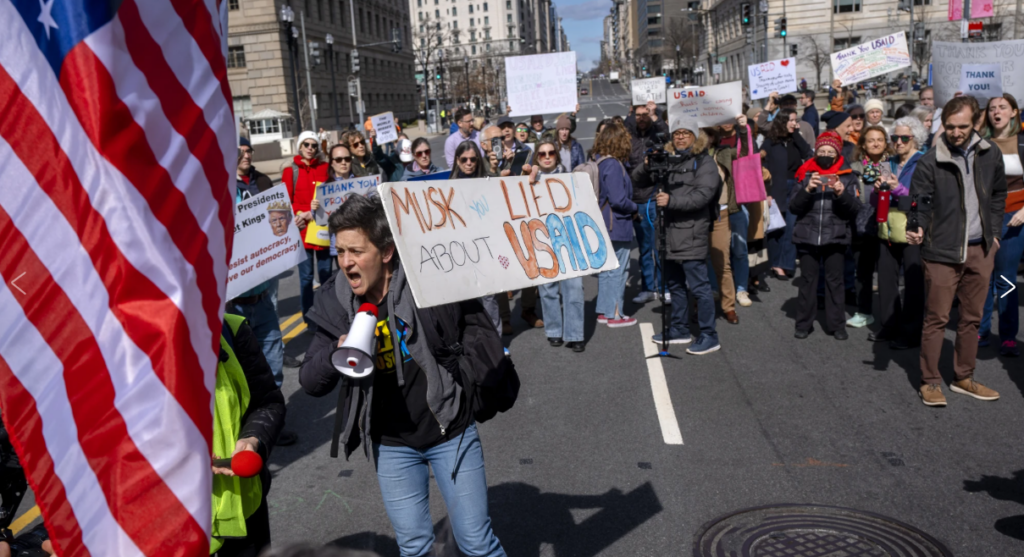- The Trump administration plans to rename USAID and integrate blockchain for aid distribution.
- Experts argue blockchain adds unnecessary complexity, with no clear advantage over existing systems.
- Critics say the move is more about tightening control over aid spending than true innovation.
A leaked memo circulating within the State Department suggests that the Trump administration is planning a major shake-up for the United States Agency for International Development (USAID). The document, first reported by Politico, outlines a plan to rename the agency US International Humanitarian Assistance (IHA) and bring it directly under the Secretary of State’s control.
But one of the most surprising details? A proposed shift to blockchain technology for aid distribution.
Blockchain in Foreign Aid—A Real Innovation or Unnecessary Tech?
According to the memo, blockchain will be leveraged in the agency’s procurement process to increase security, transparency, and traceability of aid distributions.
“All distributions would also be secured and traced via blockchain technology to radically increase security, transparency, and traceability,” the memo states. “This approach would encourage innovation and efficiency among implementing partners and allow for more flexible and responsive programming focused on tangible impact rather than simply completing activities and inputs.”
What exactly this means remains unclear. The document does not specify whether USAID would transfer funds using stablecoins or cryptocurrencies or simply use blockchain as a ledger to track disbursements. Either way, the proposed tech integration has taken many within the agency by surprise.
USAID Staff and Experts Push Back
For USAID staffers already facing uncertainty about their future, the blockchain initiative adds another layer of confusion. The agency has been in limbo ever since the Department of Government Efficiency (DOGE)—led by billionaire Elon Musk—targeted it for dramatic cuts. Earlier this year, the State Department placed USAID staff on administrative leave, slashed its workforce, and halted critical payments to global partner organizations. A federal judge temporarily blocked the full dismantling of the agency, but the memo suggests that the administration is still pushing forward with its restructuring plans.

Experts are skeptical of blockchain’s role in humanitarian aid. Linda Raftree, a consultant specializing in tech for humanitarian groups, says blockchain often presents a solution to a problem that doesn’t exist.
“It feels like a fake technological solution for a problem that doesn’t exist,” Raftree argues. “I don’t think we were ever able to find an instance where people were using blockchain where they couldn’t use existing tools.”
Other analysts agree. Giulio Coppi, a humanitarian tech expert with Access Now, suggests blockchain has yet to prove its superiority over traditional payment systems.
“There’s no proven advantage that it’s cheaper or better,” Coppi states. “The way it’s been presented is this tech solutionist approach that has been proven over and over again to not have any substantial impact in reality.”
Some Success Stories, But Major Challenges Remain
Despite the criticism, blockchain has been tested in humanitarian work before. In 2022, the UN High Commissioner for Refugees (UNHCR) piloted stablecoin cash assistance for Ukrainians displaced by war. The Kenya Red Cross Society has also experimented with blockchain-based disbursements, working with the International Committee of the Red Cross to develop the Humanitarian Token Solution (HTS).
Yet, not everyone in the field is convinced. A representative from an NGO currently using blockchain, speaking anonymously, acknowledges that stablecoins can sometimes be a faster and more efficient way to distribute aid. However, they warn that forcing smaller NGOs to adopt new systems could be a financial burden, especially for local organizations on the front lines of disaster response.
A Push for Greater Control Over Aid Spending?
The memo’s real goal may be less about tech innovation and more about tightening control over aid distribution. The document proposes a shift toward outcome-based funding, stating, “Tying payment to outcomes and results rather than inputs would ensure taxpayer dollars deliver maximum impact.”
A USAID employee, speaking anonymously, points out that many existing contracts already operate this way. However, they caution that rigid outcome-based agreements don’t always work in crisis zones where needs shift unpredictably.
“Those kinds of agreements are often not flexible enough for the environments we work in,” they explain. “In conflict or disaster zones, situations can change quickly, meaning that what an organization may be able to do or need to do can fluctuate.”
Raftree believes this language plays into claims by Musk and the administration that USAID was riddled with inefficiencies and corruption.
“It’s not like USAID was delivering tons of cash to people who hadn’t done things,” she says.
What Happens Next?
The future of USAID—and its proposed blockchain transformation—remains uncertain. As staff and aid organizations scramble to interpret the memo’s implications, the broader humanitarian community is left questioning whether this is truly about modernizing aid or simply a high-tech rebranding of bureaucratic control.














